Saturday, September 25, 2004
Silvered Æ antoninianus, Gallienus, Rome, Göbl 588w
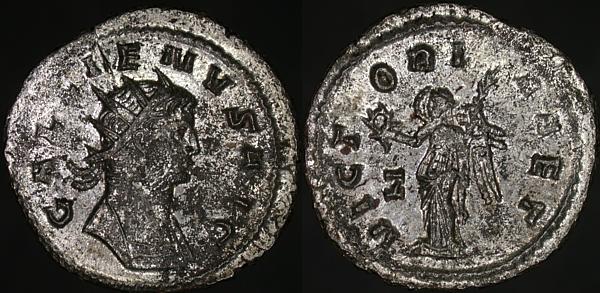
GALLIENVS AVG, Radiate cuirassed bust right | VICTORIA AET, Victory standing left holding wreath left and palm right. Z in left field.
Sometimes a coin can't be photographed well without a more practiced photographer than I. This is a type that gives me fits: a bronze coin with a badly imperfect silver surface. Bright lights skimmed over the surface at a low angle will white out the highlights with glare, less bright flat lighting to avoid glare overemphasizes the reflective differences between good and bad areas of silver.
I could, presumably, build or buy big umbrella reflectors that would allow me to use indirect bright light for these coins, to try to wash out the different areas without excessive glare, and then get the next bit of lighting kit for the next problem coin, and wind up with a photographic hobby.
Instead, I will concentrate on collecting ancient coins, and sometimes take disappointing pictures.
Friday, September 24, 2004
Æ30, Side and Attalia in Pamphylia, Gallienus, SNG France 928
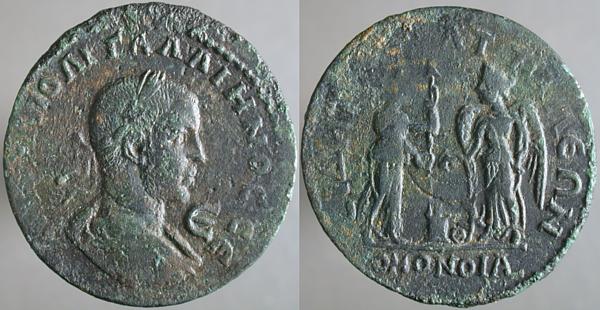
ΑVΤ [...] ΠΟ ΛΙ ΓΑΛΛΙΗΝΟC CΕ, Laureate draped bust right, E before | CΙΔΗΤ[...]ΑΤ_ΤΑΛΕΩΝ / ΟΜΟΝΟΙΑ, Athena standing right, holding spear and Nemesis standing left, with wheel and gryphon at feet, clasping hands; altar between.
Roman provincial coins jointly issued by two cities aren't uncommon, but neither are they perfectly understood: alliance between sovereign cities in Hellenistic and earlier times is easily understood, but alliance between cities already both under Roman control rather less so. I presume that these were ad-hoc commercial alliances, perhaps pooling funds for some common public display.
A little about Attalia here, and about the bigger, better-known Side here.
Thursday, September 23, 2004
Billon antoninianus, Gallienus, Köln, Göbl 877f
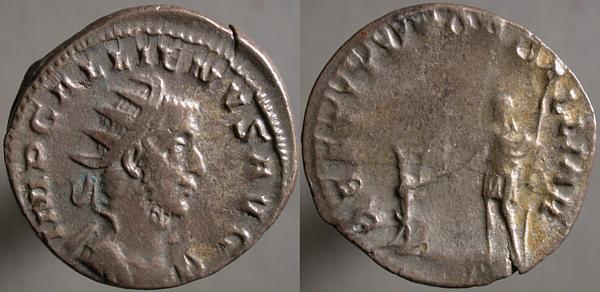
IMP GALLIENVS AVG, Radiate cuirassed bust right | RESTITVTOR GALLIAR, Gallienus in military garb, right, raising kneeling Gallia.
This was issued fairly early in the joint reign of Valerian and Gallienus, which began in 253 CE. Unlike many coins of that time, it's known only with Gallienus obverses, presumably because it particularly honors his success in the West, "restoring Gaul", while his father was in the Eastern part of the empire.
I've already posted some quite similar coins: this, with the same reverse, but a longer obverse legend and an even more military bust, and this slighly later issue.
Wednesday, September 22, 2004
Æ18, Seleukid kingdom, Antiochos VI Dionysus, c. 145-142 BCE, Sear Greek 7083
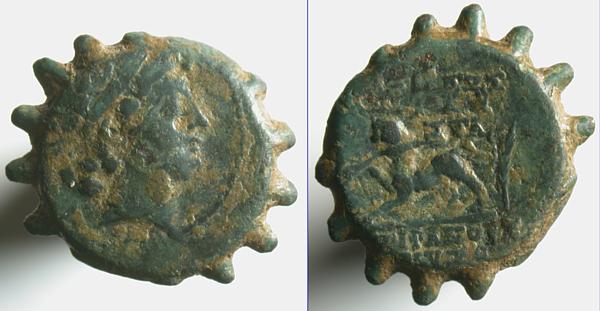
Radiate head right | Panther walking left, palm over shoulder, [ΒΑΣΙ]ΛΕΩΣ ΑΝΤΙΟΧΟΥ above, ΕΠΙΦΑΝΟΥΖ ΔΙΟΝΥΣΟΥ below. ΣΤΑ over cornucopia right.
Much good information of the Seleukids at seleukids.org
The founder of the dynasty, Seleukos I ("Nikator") was a general under Alexander the Great, and following Alexander's death intrigued with other Macedonian military leaders and ultimately ruled much of Asia Minor. He was assassinated in 280 BCE.
More than an assassination-packed century later, the infant son of Alexander Balas was was placed on the throne in opposition to Demetrios II (son of the man who'd killed Balas) for a few years until his regent, Diodatus, killed him and briefly reigned as Tryphon.
The Seleukid kingdom finally fell to a Roman army under Pompey Magnus in 64 BCE.
The odd bottle-cap shape of this coin was repeatedly adopted and abandoned by the Seleukids, and their clients. The blanks were cast this way, apparently just for esthetic value.
Tuesday, September 21, 2004
Æ28, Tarsus in Cilicia, Salonina, SNG Levante 1199 (this coin)
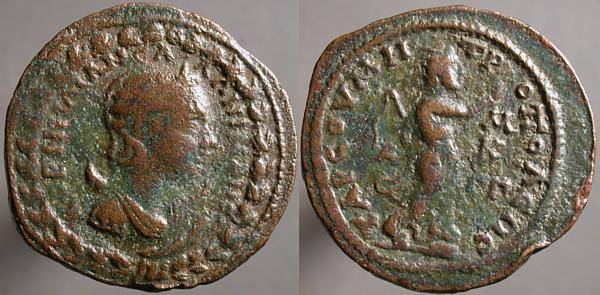
ΚΟΡΝΗΛΙΑΝ CΑ_ΛΩΝΙΝΑΝ CΕ, Diademed draped bust right, crescent behind shoulders | ΤΑΡCΟV ΜΗ_ΤΡ_ΟΠΟΛΕΩC, Helios advancing right, hand raised right, carrying whip behind. Α in left field, Μ / Κ / Γ Γ in right.
Back in July I posted a very similar coin (maybe the same reverse die) with a lovely desert patina. This, though, has a particularly interesting obverse, with Salonina's name and image within a wreath.
I don't know the significance of that. Salonina didn't die until after the assassination of her husband, so this isn't a funerary symbol.
While I don't yet have a copy of SNG Levante, I do trust the seller to have attributed it correctly, and know that the collection of Eduardo Levante has been sold recently, and have managed to purchase a few.
Monday, September 20, 2004
Billon antoninianus, Valerian, Samosata, Göbl 1681e
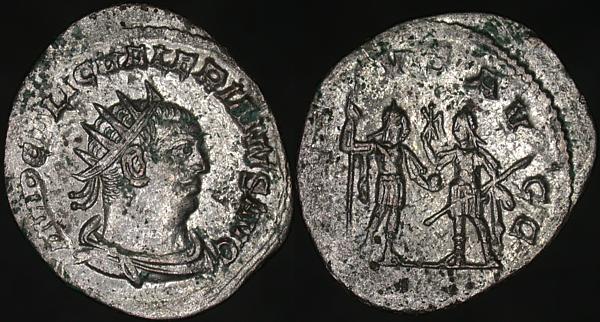
IMP C P LIC VALERIANVS AVG, Radiate draped cuirassed bust right | VIRTVS AVGG, Valerian and Gallienus standing face-to-face, left holding globe and spear, right holding Victory and spear.
Being a collector, I'm always looking to find what no one else has found. Sometimes it works, usually not.
There are some dark spots in the exergue here that I thought just might be pellets; little dots that are very much known for this mint, but not this issue. They'd be just enough difference from what's known to be significant.
But they're not pellets, they're just dark trivial breaks in the surface of the coin. They're without importance.
But, a lowball bid, and a $10.50 win, it was a sensible risk to take, and no regrets that it didn't pay off.
Sunday, September 19, 2004
"dating back to 30BC"
Æ31, Tarsus in Cilicia, Valerian, SNG Paris 1799
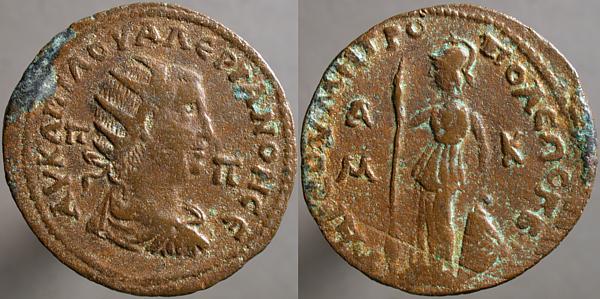
ΑVΤ ΚΑΙ Π Λ ΟVΑΛΕΡΙΑΝΟΝ CΕ, Radiate draped cuirassed bust right, Π before and behind | ΤΑΡCΟV ΜΗΤΡΟ_ΠΟΛΕΩC Γ Β, Athena standing facing, head left, holding spear left and shield at feet right. Α / Μ in left field, Κ in right.
Only a few weeks ago I posted this similar coin, which I think shows Athena on the reverse. This one, there's no doubt.
There are differences in the details of the obverse and reverse legends, none very substantial, just a letter added, omitted, or moved, here and there. As an entusiastic collector, I obsess on exactly this sort of minutiae, of course.

